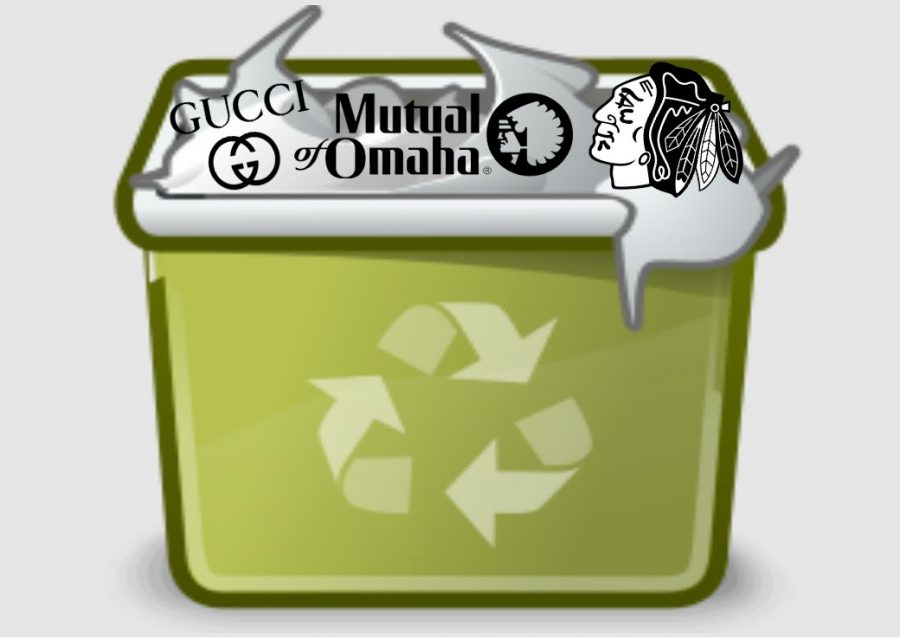Respect over intent
Solving cultural appropriation is a matter of becoming educated to ensure change
Logos are a popular way to introduce the aesthetic and values of a company, brand, or business. However, when the design is harmful or insensitive to a culture it can shut out a large population of people. Being smart with the symbolism used is important to create a welcoming and friendly environment.
December 3, 2020
There has been an increasing focus on the logos, symbols and names that popular companies use as a result of events like the Black Lives Matter protests over the summer. Pressure for racial justice has pushed people to adopt a more aware and proactive mindset. One of the most recent examples of this improved thinking has been the replacement of the Mutual of Omaha logo which originally depicted a Native American chief.
Mutual of Omaha is just one company in a long list that has made changes or completely redesigned a logo or brand name in order to be less offensive to another culture. The original logo depicted a Native American figurehead and is being replaced by a lion which is a nod to the popular tv show “Wild Kingdom.” This redesign couldn’t have come at a better time, seeing as how November houses Red Shawl Day and Native American Heritage Month. The original logo had been with the company for 70 years before the change was initiated.
Unfortunately, this has become a rather common story in both the athletic and professional world. Sports teams like the Chicago Blackhawks, a professional hockey team, have faced serious backlash for the continued use of a Native American figure as their logo. Behavior like this is nothing new and mostly unchanging due to things like performative activism. This is where the people calling for change only to increase social capital rather than real devotion to the issues. Performative activism has enabled people to speak out against these issues but take little to no action to create actual change.
Following the increasing backlash the hockey team faced, they released a statement about their stance on changing the logo.“We recognize there is a fine line between respect and disrespect, and we commend other teams for their willingness to engage in that conversation,” the statement says. “Moving forward, we are committed to raising the bar even higher to expand awareness of Black Hawk and the important contributions of all Native American people. We will continue to serve as stewards of our name and identity, and will do so with a commitment to evolve.”
When people raise issues with a logo or name, it is justifiable considering the impact of American history within their communities. When Native and African Americans have suffered for so long, it is within their rights to simply ask that big brands and companies don’t profit off of using an image or name that has no significance to them or their culture. Although the intention of helping teach people about Black Hawk seems good, when the members of that community simply ask to stop using the image there shouldn’t be a debate.
The fashion industry is just another example of an industry that participates in cultural appropriation and racism time and time again without reflecting on the issue. Popular designer brand Gucci released a black turtleneck sweater that featured a mouth cut out that included a wide red outline like looked like exaggerated lips. The company received backlash for the sweater’s resemblance to blackface, which was used by white actors to play African Americans in a dehumanizing and humiliating way.
The brand took to their Twitter to post an apology where they stated “we consider diversity to be a fundamental value to be fully upheld, respected, and at the forefront of every decision we make.”
This isn’t enough. Although the brand took the sweater off of the website and issued an apology, that does not showcase any real change within the brand. It’s easier to say sorry than it is to think about why the design was created and put on the runway in the first place. How is it that no one within the company saw a problem with this and said something?
This could, however, be avoided if emerging companies were able to think about the implications of their designs and what message it sends to the audience. A more widespread awareness would ensure companies are being held accountable for the decision they make.
The growing awareness could be due to a sense of guilt or responsibility for the treatment Native Americans have endured since the arrival of the colonists. According to the National Congress of American Indians, these communities are still affected by a lower life expectancy by 5.5 years, and the highest suicide rate amongst teenagers from any ethnicity/race by 2.5%. The NCAI also reports that American Indians and Alaska Natives are more likely to experience violent crimes at a rate of two and a half times higher than the national average. In comparison to all other racial/ethnic groups, they are two times more likely to experience rape or sexual assault crimes.
African Americans have also felt the negative impact within their communities. According to the Mental Health America website, 16% of African American people reported having a mental illness. Binge drinking, smoking, illicit drug use and prescription pain reliever misuse are more common among African American adults with mental illnesses. Not only are they overrepresented in the American Prison system but they make up about 40% of the prison population. These issues aren’t new and rarely see effort put into creating change.
Native Americans and African Americans of course aren’t the only groups that face these types of challenges. However, they are the most overlooked when it comes to pursuing actual change. Cultural appropriation only seems harmless to people that don’t understand and choose not to educate themselves on the history of symbols and logos.







